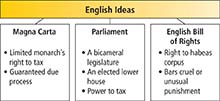CHAPTER 3: Quick Study Guide
Progress Monitoring Online
For: Self-test with vocabulary practice
Web Code: nca-0309
- Diversity in the Colonies

- The Three Regions of the 13 Colonies
Region Climate Economy Population New England Colonies Cold winters; short growing season Fishing; shipbuilding; trade; lumber; small subsistence farms Few slaves or immigrants; more families; fast-growing population Middle Colonies Temperate; moderate growing season Wheat, barley, and rye crops grown on moderate-sized farms; trade Attractive to immigrants; tolerant of religious and ethnic differences Southern Colonies Warm climate; long growing season Cash crops of tobacco, rice, and indigo grown on large plantations using slave labor More men than women; indentured servants; enslaved African Americans a majority in some areas - English Ideas Influence the Colonies
- The French and Indian War
 Quick Study Timeline
Quick Study Timeline
For: Interactive timeline
Web Code: ncp-0311
Table of Contents
Prentice Hall: United States History
CHAPTER 1 Many Cultures Meet (Prehistory–1550)
1 The American Indians
2 The Europeans
3 The West Africans
4 First Encounters
American Issues Connector: Global Interdependence
Quick Study Guide and Assessment
CHAPTER 2 Europeans Establish Colonies (1492–1752)
1 Spain’s Empire in the Americas
2 The French Empire
3 England’s Southern Colonies
4 The New England Colonies
5 The Middle Colonies
Quick Study Guide and Assessment
CHAPTER 3 The American Colonies Take Shape (1607–1765)
1 Immigration and Slavery
2 The American Colonies and England
3 Comparing Regional Cultures
4 Wars of Empire
Quick Study Guide and Assessment
Reflections: Seeds of Change
CHAPTER 4 The American Revolution (1765–1783)
1 Causes of the Revolution
2 Declaring Independence
Declaration of Independence
3 Turning Points of the War
4 War’s End and Lasting Effects
Quick Study Guide and Assessment
CHAPTER 5 Creating the Constitution (1781–1789)
1 A Confederation of States
2 Drafting the Constitution
3 Ratifying the Constitution
American Issues Connector: Expanding and Protecting Civil Rights
Quick Study Guide and Assessment
The Constitution and Bill of Rights
CHAPTER 6 The New Republic (1789–1816)
1 Government and Party Politics
2 The Struggle Over Foreign Policy
3 The Age of Jefferson
4 The War of 1812
Quick Study Guide and Assessment
Reflections: Jefferson’s Vision
CHAPTER 7 Nationalism and Sectionalism (1812–1855)
1 Industry and Transportation
2 Sectional Differences
American Issues Connector: Sectionalism and National Politics
3 An Era of Nationalism
4 Democracy and the Age of Jackson
5 Constitutional Disputes and Crises
Quick Study Guide and Assessment
CHAPTER 8 Religion and Reform (1812–1860)
1 A Religious Awakening
American Issues Connector: Church and State
2 A Reforming Society
3 The Antislavery Movement
4 The Women’s Movement
Quick Study Guide and Assessment
CHAPTER 9 Manifest Destiny (1800–1850)
1 Migrating to the West
2 Texas and the Mexican-American War
3 Effects of Territorial Expansion
Quick Study Guide and Assessment
Reflections: An Age of Reform
CHAPTER 10 The Union in Crisis (1846–1861)
1 Slavery, States’ Rights, and Western Expansion
American Issues Connector: Federal Power and States’ Rights
2 A Rising Tide of Protest and Violence
3 Political Realignment Deepens the Crisis
4 Lincoln, Secession, and War
Quick Study Guide and Assessment
CHAPTER 11 The Civil War (1861–1865)
1 Resources, Strategies, and Early Battles
2 African Americans and the War
3 Life During the War
4 Turning Points of the War
5 The War’s End and Impact
Quick Study Guide and Assessment
CHAPTER 12 The Reconstruction Era (1865–1877)
1 Rival Plans for Reconstruction
American Issues Connector: Checks and Balances
2 Reconstruction in the South
3 The End of Reconstruction
Quick Study Guide and Assessment
Reflections: The Civil War
CHAPTER 13 The Triumph of Industry (1865–1914)
1 Technology and Industrial Growth
2 The Rise of Big Business
3 The Organized Labor Movement
American Issues Connector: Technology and Society
Quick Study Guide and Assessment
CHAPTER 14 Immigration and Urbanization (1865–1914)
1 The New Immigrants
2 Cities Expand and Change
American Issues Connector: Migration and Urbanization
Social and Cultural Trends
Quick Study Guide and Assessment
CHAPTER 15 The South and West Transformed (1865–1900)
1 The New South
2 Westward Expansion and the American Indians
American Issues Connector: American Indian Policy
3 Transforming the West
Quick Study Guide and Assessment
CHAPTER 16 Issues of the Gilded Age (1877–1900)
1 Segregation and Social Tensions
American Issues Connector: Women in American Society
2 Political and Economic Challenges
3 Farmers and Populism
Quick Study Guide and Assessment
Reflections: Little Bighorn
CHAPTER 17 The Progressive Era (1890–1920)
1 The Drive for Reform
2 Women Make Progress
American Issues Connector: Social Problems and Reforms
3 The Struggle Against Discrimination
4 Roosevelt’s Square Deal
5 Wilson’s New Freedom
Quick Study Guide and Assessment
CHAPTER 18 An Emerging World Power (1890–1917)
1 The Roots of Imperialism
American Issues Connector: Territorial Expansion of the United States
2 The Spanish-American War
3 The United States and East Asia
4 The United States and Latin America
Quick Study Guide and Assessment
CHAPTER 19 World War I and Beyond (1914–1920)
1 From Neutrality to War
American Issues Connector: America Goes to War
2 The Home Front
3 Wilson, War, and Peace
4 Effects of the War
Quick Study Guide and Assessment
Reflections: The Progressive Era
CHAPTER 20 The Twenties (1919–1929)
1 A Booming Economy
2 The Business of Government
3 Social and Cultural Tensions
American Issues Connector: U.S. Immigration Policy
4 A New Mass Culture
5 The Harlem Renaissance
Quick Study Guide and Assessment
CHAPTER 21 The Great Depression (1928–1932)
1 Causes of the Depression
2 Americans Face Hard Times
3 Hoover’s Response Fails
Quick Study Guide and Assessment
CHAPTER 22 The New Deal (1932–1941)
1 FDR Offers Relief and Recovery
2 The Second New Deal
3 Effects of the New Deal
American Issues Connector: Government’s Role in the Economy
4 Culture of the 1930s
Quick Study Guide and Assessment
Reflections: Art in the New Deal
CHAPTER 23 The Coming of War (1931–1942)
1 Dictators and Wars
2 From Isolation to Involvement
3 America Enters the War
Quick Study Guide and Assessment
CHAPTER 24 World War II (1941–1945)
1 The Allies Turn the Tide
2 The Home Front
3 Victory in Europe and the Pacific
4 The Holocaust
5 Effects of the War
Quick Study Guide and Assessment
CHAPTER 25 The Cold War (1945–1960)
1 The Cold War Begins
2 The Korean War
3 The Cold War Expands
4 The Cold War at Home
American Issues Connector: Civil Liberties and National Security
Quick Study Guide and Assessment
CHAPTER 26 Postwar Confidence and Anxiety (1945–1960)
1 An Economic Boom
2 A Society on the Move
3 Mass Culture and Family Life
4 Dissent and Discontent
Quick Study Guide and Assessment
Reflections: Postwar Changes
CHAPTER 27 The Civil Rights Movement (1945–1975)
1 Early Demands for Equality
2 The Movement Gains Ground
3 New Successes and Challenges
American Issues Connector: Voting Rights
Quick Study Guide and Assessment
CHAPTER 28 The Kennedy and Johnson Years (1960–1968)
1 Kennedy and the Cold War
2 Kennedy’s New Frontier
3 Johnson’s Great Society
American Issues Connector: Poverty and Prosperity
Quick Study Guide and Assessment
CHAPTER 29 The Vietnam War Era (1954–1975)
1 Origins of the Vietnam War
2 U.S. Involvement Grows
3 The War Divides America
4 The War’s End and Impact
American Issues Connector: America and the World
5 Nixon and the Cold War
Quick Study Guide and Assessment
CHAPTER 30 An Era of Protest and Change (1960–1980)
1 The Counterculture
2 The Women’s Rights Movement
3 The Rights Revolution Expands
4 The Environmental Movement
American Issues Connector: Interaction With the Environment
Quick Study Guide and Assessment
CHAPTER 31 A Crisis in Confidence (1968–1980)
1 Nixon and the Watergate Scandal
2 The Ford and Carter Years
3 Foreign Policy Troubles
Quick Study Guide and Assessment
Reflections: The Civil Rights Struggle
CHAPTER 32 The Conservative Resurgence (1980–1993)
1 The Conservative Movement Grows
2 The Reagan Revolution
3 The End of the Cold War
4 Foreign Policy After the Cold War
Quick Study Guide and Assessment
CHAPTER 33 Into a New Century (1992–Today)
1 The Computer and Technology Revolutions
2 The Clinton Presidency
3 Global Politics and Economics
4 The George W. Bush Presidency
5 Americans Look to the Future
American Issues Connector: Education and American Society
Quick Study Guide and Assessment
Reflections: Enduring Issues
Five Themes of Geography
Profile of the Fifty States
Atlas
Presidents of the United States
Economics Handbook
Landmark Decisions of the Supreme Court
Documents of Our Nation
English and Spanish Glossary
Index
Acknowledgments







